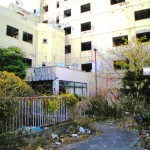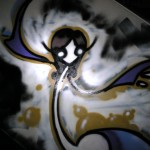The gutted shell of the abandoned Keishin Hospital stands blank and ghostly on the rural Kanagawa sky-line. It once housed state-of-the-art radiology and cancer departments, now the only pieces of equipment remaining are the chairs bolted to the floor in the dentist’s office. Up close its walls are a vibrant cacophony of ever-changing grafitti, its forecourt a wash of shattered glass and empty spray-paint cans, its encircling car park overgrown with a thick smog of twisted brown underbrush. All record of its previous life has been erased by decades of vandalism, theft, and neglect.

This is an old haikyo that I never got round to posting. I actually went in January (2008), before I’d thought of haikyo-camping and before I got my new camera the Powershot A650IS. All the same- I’d still thought of going in at night to intensify the experience- so that’s what I did.
I arrived in the Kanagawa country-side in late afternoon and as usual forsook taxis for the long isolating walk to the location. I arrived as the day was drawing to a close, so rushed around for the final 30 minutes of daylight taking whatever photos I could. The hospital was very easy to enter, requiring no climbing at all, a simple and spacious step round a barb wire fence.

From online photos I’ve seen, the hospital was originally left with a fair bit of equipment, clothing, papers and general paraphernalia lying all around and inside it. By the time I got there however it had been completely trashed and gutted. The dentist’s building at the front was the only room with any kind of furniture remaining- metal chairs that I presume were too difficult to destroy or uproot. The walls were all shredded of plaster and sometimes wholly put through, the ceilings were gouged leaving drifts of insulation, broken slats, and ceiling panels on the floor. All the windows were broken, and piles of shattered glass lay mounded in the corners. Most of the doors had been torn from their hinges, in some cases re-possessed to serve as sky-walk bridges between the various rooves of the hospital complex.
But it wasn’t all destruction. Covering almost every available wall was a vast array of graffiti in many different shapes, sizes, and styles, almost all of it very high quality and on occasion photo-real enough to scare the socks off me in the dark.

I entered the building by the round-about route round the side, which is my standard. I avoid entering by the front door whenever possible- I like to scout the lay of the land, make sure I’m not walking into a trap. That’s overly wary maybe, but it just comes naturally. In the process of climbing a roof to go round the side I saw a police car on the road nearby, which flicked on its sirens. For a moment I froze, then dashed off in fear they were coming for me. I got inside and happily their sirens blared away.
Once inside it was dusk, and every photograph was taken with flash. It’s a shame because the art on the walls was stunning. As it got darker, my progress through the building slowed. As usual, I wasn’t afraid of ghosts or monsters, rather bumping into yakuza or street-punk grafitti artists in the dark. By the third floor I was checking every hall and every room to make sure no-one was hiding out. Several times I was startled by noises, doors moving slightly as I went by, and some of the grafitti faces themselves.

By the top floor and the roof 6 stories high I was in a state of high tension. I was almost certain there would be someone right at the top, up the ladder bolted to a water-tower type block. I climbed up with extreme trepidation, the pipe to hand, flashlight off. Even at the top I was terrified there would be someone hiding behind the white water tank and could barely bring myself to go round to check. When I did go round to check, I became worried whoever was hiding had just circled around to block my exit.

In the end I put the fear aside, climbed on top of the water tank, and enjoyed the view from the highest point around for miles. Black countryside dotted with lights and roads. I lay back, forced myself to calm down, and ate a sandwich.
On the way down I bolted through as usual, taking no time to check every room again, and stepped out onto the street with a great deal of relief. I then got lost trying to walk back a different way to the station. Ah well, you can’t win them all.
Here are the photos.
FACTFILE
Location– Kanagawa.
Entry – Down the side of a fence and round the back of the hospital.
Highlights– Freaking out at every noise in the dark, making it to the very top but still feeling there was someone lurking near me.
RUINS / HAIKYO
You can see all MJG’s Ruins / Haikyo explorations here:
[album id=4 template=compact]













Comments 16
I am surprised and amazed at the volume and high quality of the grafitti.
I am also surprised with how damaged it looks that the community does not demand that it be torn down.
Author
There was actually a whole lot more graffiti that I didn’t include in this post. I’ve thought of going back to shoot it during the day- it would make an excellent gallery.
About the community- in that area there’s not a lot of local residents, just a big road, some services, some low pop-density farms, and old people in retirement. Plus I think the culture is just different here- they won’t tear it down until someone buys the land and puts up the money to build something else in its place.
wow, what colourful graffiti…not had time to read all about it yet..but was very struck with that bright red graffiti….what is any of it saying (in English)? I thought it was from an art gallery!
Author
Hey mom- that’s a good question about what the graffiti says- I’m afraid I have no idea though. Some of them might be in Japanese, but they’re so stylized, and my Japanese is so limited anyway- I can’t recognize anything.
Thanks for sharing this – looks great, am gonna have to lay my hands on a copy of that book, where did you get it???
Author
thejapaneseeye- I got it in Junkudo, but you could probably pick one up through Amazon, or any other fairly large bookstore. There’s a fair few others too, but this is the only one I found with maps.
Thanks for that got a copy after a bit of searching, now trying to decipher the kanji, with this one what was the nearest station on that map is it 茅ケ崎 (chigasuma)?
That would be Chigasaki on the Tokaido Line, if I’m not mistaken.
May I ask what the title is (or even better ISBN) of the book you use?
Visited this place. Actually ran into some haikyu cosplayers who were just packing up. Seems this may be an emerging trend.
hi, wondering how to get to this place? thanks!
Author
J-eye, Jackson B, Paul- Hey guys, sorry I never replied to these comments. The book is on rotation in my sidebar now- available through the Japanese Amazon.
bored- Hi there, I`ll direct you to the book mentioned above- Nippon no Haikyo. It has lots of haikyo locations in it.
I tried to go to this place today. Barricades and cameras all around… It’s impossible to enter this hospital anymore.
Barricaded already?! Wow, a few months sooner than I’d put my money on. Looks like this local council actually has a functional bureaucracy.
As I’m writing these words, the Keishin Hospital is getting demolished. That’s a sad news…
Has this place really been demolished,? I can find any information about it’s demolition or it’s existence.